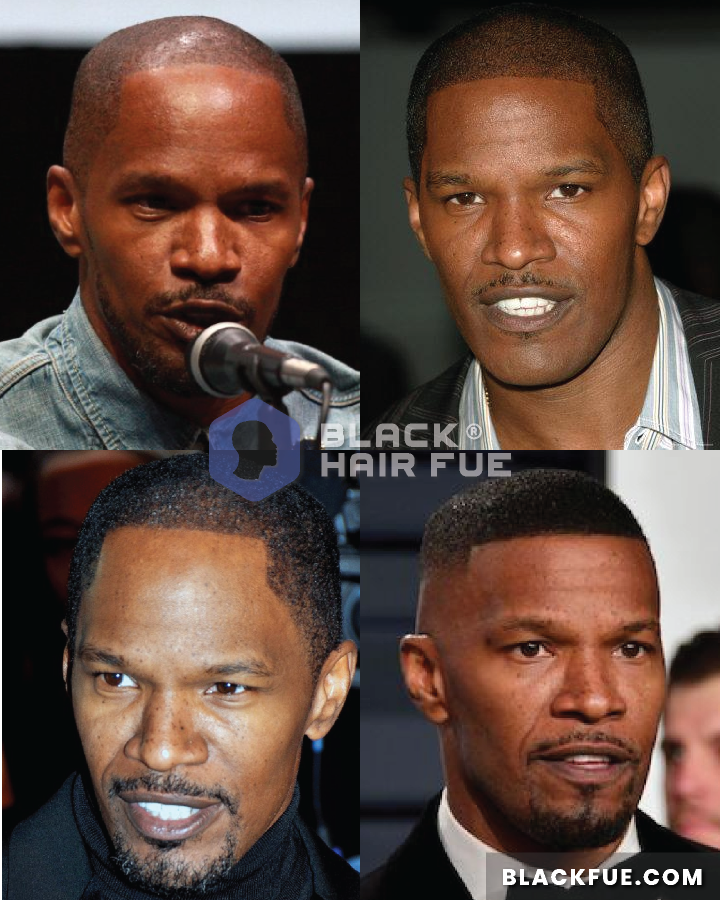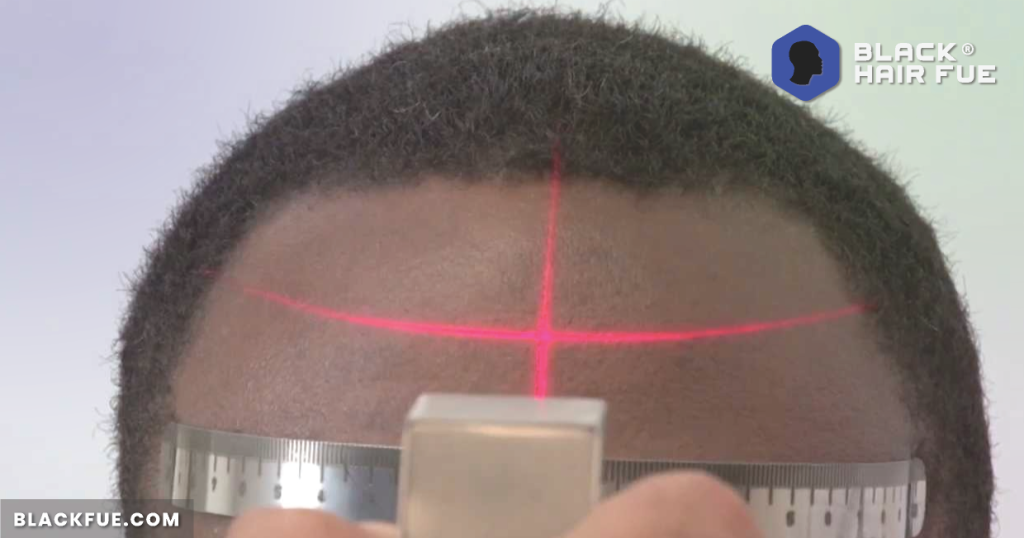The Perfect Hairline for Black FUE Transplants
The hairline is one of the most critical aspects of an FUE hair transplant, especially for Black patients. A well-designed, natural-looking hairline can greatly enhance a patient’s appearance and boost their self-confidence. The perfect hairline should be symmetrical, with a gentle curve that follows the natural contours of the forehead and a gradual density gradient. However, achieving this ideal hairline requires careful consideration of the unique characteristics of Black hair and scalp, such as the curly, coarse texture and the higher risk of keloid scarring. Hair transplant surgeons must adapt their techniques to address these specific needs and create a hairline that seamlessly blends with the patient’s existing hair.
Understanding the Unique Characteristics of Black Hair and Scalp
Black hair and scalp have unique characteristics that must be considered during an FUE hair transplant. Black hair tends to be curly, coarse, and dense, with a curved follicle shape that requires special attention during extraction and transplantation. Additionally, the scalp of Black patients may have a higher risk of keloid scarring, a type of raised scar that can occur after any skin injury, including hair transplant procedures.
To achieve the perfect hairline for Black patients, hair transplant surgeons must have a profound understanding of these unique characteristics and adapt their techniques accordingly. This includes using specialized tools and methods for extracting and transplanting curly hair follicles, as well as taking precautions to minimize the risk of keloid scarring.

Defining the Perfect Hairline
A perfect hairline is one that looks natural, complements the patient’s facial features, and enhances their overall appearance. It should be symmetrical, with a gentle curve that follows the natural contours of the forehead. The hairline should also have a gradual density gradient, with the hair becoming progressively denser as it moves back from the forehead.
For Black patients, creating a perfect hairline also involves considering the unique texture and growth patterns of their hair. A skilled hair transplant surgeon will carefully select and place each follicular unit to mimic the natural direction and curl of the patient’s hair, ensuring a seamless blend with the existing hair.

Advanced Techniques for Designing the Perfect Hairline
Hair transplant surgeons use various methods and tools to design the perfect hairline for their patients. One of the most advanced techniques is the use of a hairline laser tool. This device projects a laser line onto the patient’s forehead, allowing the surgeon to visualize and mark the ideal hairline shape with precision. The laser tool takes into account the patient’s facial structure, symmetry, and natural hair growth patterns, ensuring a customized and natural-looking hairline design.
Other methods for designing the hairline include:
- 3D Imaging: Some hair transplant clinics use 3D imaging software to create a virtual model of the patient’s head and simulate different hairline designs. This allows the patient to preview the potential results and make adjustments before the actual procedure.
- Artistic Approach: Skilled hair transplant surgeons often have an artistic eye and can freehand the hairline design based on their experience and understanding of facial aesthetics. They consider factors such as the patient’s age, facial features, and hair characteristics to create a customized hairline that looks natural and complements the patient’s appearance.
- Stencils and Guides: Some surgeons use pre-made stencils or guides to help them create a symmetrical and proportionate hairline. These tools can be adjusted to suit the patient’s individual needs and ensure a consistent and accurate hairline design.
Regardless of the method used, the goal is always to create a hairline that looks natural, complements the patient’s facial features, and meets their individual goals and expectations.
The Hairline Laser Assist Tool
One of the most advanced tools hair transplant surgeons use to design the perfect hairline is the laser hairline assist device. This innovative technology projects a laser line onto the patient’s forehead, allowing the surgeon to visualize, measure and mark out the ideal hairline shape and position with a high degree of accuracy and precision.
The laser tool takes into account key factors like the patient’s unique facial structure, symmetry, and natural hair growth patterns to create a fully customized hairline design. This is especially valuable for Black patients, as their distinct hair characteristics, such as curl and coarseness, require careful consideration and planning to ensure a seamless, natural-looking result.
By using the laser hairline assist tool, surgeons can create hairline designs that are perfectly balanced, symmetrical, and complementary to each patient’s features, setting the stage for optimal results from the FUE hair transplant procedure.

Key Steps in Creating the Perfect Hairline During an FUE Transplant
- Consultation and Planning: The first step in achieving the perfect hairline is a thorough consultation with a hair transplant surgeon. During this consultation, the surgeon will assess the patient’s hair loss pattern, scalp condition, and facial features to determine the best hairline design. They will also discuss the patient’s goals and expectations to ensure a customized treatment plan.
- Hairline Design: Based on the consultation, the surgeon will create a personalized hairline design that takes into account the patient’s facial structure, age, and desired look. For Black patients, the surgeon will also consider the unique texture and growth patterns of their hair to ensure a natural-looking result.
- Follicular Unit Extraction: During the FUE procedure, the surgeon will carefully extract individual hair follicles from the donor area, typically the back or sides of the scalp. For Black patients, the surgeon will use specialized techniques to extract the curly hair follicles without damaging them, ensuring optimal survival rates and growth.
- Recipient Site Creation: Before transplanting the extracted follicles, the surgeon will create recipient sites in the balding or thinning areas of the scalp. These sites will be strategically placed to create a natural-looking hairline with a gradual density gradient. For Black patients, the surgeon will also consider the direction and angle of the recipient sites to ensure that the transplanted hair grows in a natural-looking pattern.
- Graft Placement: The extracted follicular units will be carefully placed into the recipient sites, with the surgeon paying close attention to the angle, direction, and depth of each graft. For Black patients, the surgeon will ensure that the curly hair follicles are transplanted in a way that mimics the natural growth patterns of their hair, creating a seamless blend with the existing hair.
Choosing the Right Hair Transplant Surgeon
Achieving the perfect hairline during an FUE hair transplant requires the expertise of a skilled and experienced hair transplant surgeon. When choosing a surgeon, Black patients should look for a professional who has extensive experience working with black hair and scalp, and who understands the unique challenges and considerations involved in creating a natural-looking hairline for this patient population.
Patients should also look for a surgeon who uses the latest techniques and technologies in FUE hair transplantation, and who has a proven track record of successful results. It is important to review before-and-after photos of the surgeon’s previous Black patients to get a sense of their skill level and aesthetic approach.
Post-Transplant Care and Maintenance
Achieving the perfect hairline during an FUE hair transplant is only the first step in the journey to a full head of natural-looking hair. Proper post-transplant care and maintenance are essential to ensure optimal results and hairline preservation.
Black patients should follow their surgeon’s post-transplant care instructions carefully, which may include gentle shampooing, avoiding certain hairstyles or treatments, and protecting the scalp from sun exposure. Regular follow-up appointments with the surgeon will also be necessary to monitor the healing process and ensure that the transplanted hair is growing as expected.
In the long term, Black patients may also need to adopt a healthy hair care regimen to maintain the health and appearance of their transplanted hair. This may include using gentle, sulfate-free hair products, avoiding harsh styling practices, and nourishing the scalp with regular moisturizing treatments.
A Hairline to Perfection
Achieving the perfect hairline during an FUE hair transplant is a complex process that requires the expertise of a skilled and experienced surgeon. For Black patients, creating a natural-looking hairline involves considering the unique characteristics of their hair and scalp, and adapting the transplant techniques accordingly.
By choosing the right surgeon, following proper post-transplant care instructions, and adopting a healthy hair care regimen, Black patients can achieve a perfect hairline that enhances their appearance and boosts their self-confidence. With the correct approach, an FUE hair transplant can be a life-changing solution for Black patients struggling with hair loss.





